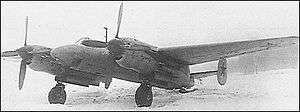Tupolev Tu-1
The Tupolev Tu-1 was a prototype Soviet night fighter variant of the Tupolev Tu-2 medium bomber that first flew after the end of World War II. It was cancelled when its experimental Mikulin AM-43V engines reached the end of their service life.
| Tu-1 | |
|---|---|
 | |
| Front-quarter view of the Tu-1 (ANT-63P) prototype | |
| Role | Night fighter |
| National origin | Soviet Union |
| Manufacturer | Tupolev |
| First flight | 22 March 1947 |
| Status | Cancelled |
| Number built | 1 |
| Developed from | Tupolev Tu-2 |
Development
Impressed by the performance of the de Havilland Mosquito the Soviets asked Tupolev to modify a Tu-2 as a high-speed day bomber with a reduced crew as the ANT-63. The second prototype of this project was ordered to be converted in February 1946 for use as a three-seat long-range interceptor capable of carrying an airborne radar set with the internal designation of ANT-63P and the official designation of Tu-1. It was given prototype Mikulin AM-43V engines driving four-bladed propellers, and fitted with new radio equipment. It reverted to the standard Tu-2S undercarriage. Two 45 mm (1.8 in) Nudelman-Suranov NS-45 guns with 50 rounds each were fitted on the underside of the nose, two 23 mm (0.91 in) Volkov-Yartsev VYa-23 or Nudelman-Suranov NS-23 cannon were fitted in the wing roots with 130 rounds per gun. The dorsal gunner was given a 12.7 mm (0.50 in) UBT machine gun with 200 rounds and the ventral gunner received a UBT with 350 rounds of ammunition. It retained the internal bomb bay which could carry up to 1,000 kg (2,200 lb) of bombs.[1]
The Tu-1 first flew on 22 March 1947 and underwent manufacturer's tests until 3 October[2] or 3 November 1947.[1] Sources disagree about the mounting of radar during these tests. Bill Gunston says that a Soviet derivative of the German FuG 220 Lichtenstein SN-2 was tested,[1] however Yefim Gordon believes that no radar was fitted at all and the short service life of the AM-43V prototype engines curtailed the planned tests and development. At any rate, the aircraft was not selected for production because its AM-43V engines were not ready for production.[2]
Specifications
Data from Gordon, OKB Tupolev: A History of the Design Bureau and its Aircraft
General characteristics
- Crew: 3
- Length: 13.6 m (44 ft 7 in)
- Wingspan: 18.86 m (61 ft 11 in)
- Height: 3.32 m (10 ft 11 in)
- Wing area: 48.8 m2 (525 sq ft)
- Airfoil: root: TsAGI-40 (13.75%) ; tip: TsAGI-40 (9.9%)[3]
- Empty weight: 9,460 kg (20,856 lb) [1]
- Gross weight: 12,755 kg (28,120 lb)
- Max takeoff weight: 14,460 kg (31,879 lb) [1]
- Powerplant: 2 × Mikulin AM-43V V-12 liquid-cooled piston engines, 1,454 kW (1,950 hp) each
- Propellers: 4-bladed constant-speed propellers
Performance
- Maximum speed: 641 km/h (398 mph, 346 kn)
- Range: 2,250 km (1,400 mi, 1,210 nmi)
- Service ceiling: 11,000 m (36,000 ft)
- Wing loading: 261.37 kg/m2 (53.53 lb/sq ft)
Armament
- Guns:
- 2 × 45 mm Nudelman-Suranov NS-45 cannon
- 2 × 12.7 mm UBT machine guns
- Bombs: up to 1,000 kg (2,200 lb) of bombs
See also
Aircraft of comparable role, configuration and era
References
| Wikimedia Commons has media related to Tupolev Tu-1. |
- Gunston, p. 122
- Gordon, p. 91
- Lednicer, David. "The Incomplete Guide to Airfoil Usage". m-selig.ae.illinois.edu. Retrieved 16 April 2019.
- Gordon, Yefim; Rigamant, Vladimir (2005). OKB Tupolev: A History of the Design Bureau and its Aircraft. Hinckley, England: Midland Publishing. ISBN 1-85780-214-4.
- Gunston, Bill (1995). Tupolev Aircraft since 1922. Annapolis, MD: Naval Institute Press. ISBN 1-55750-882-8.